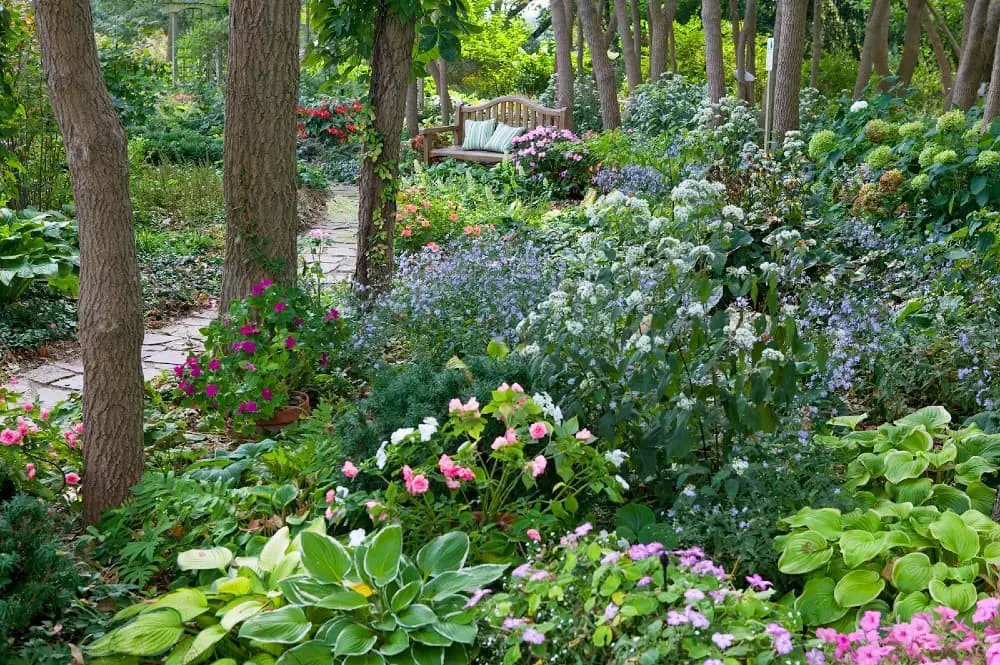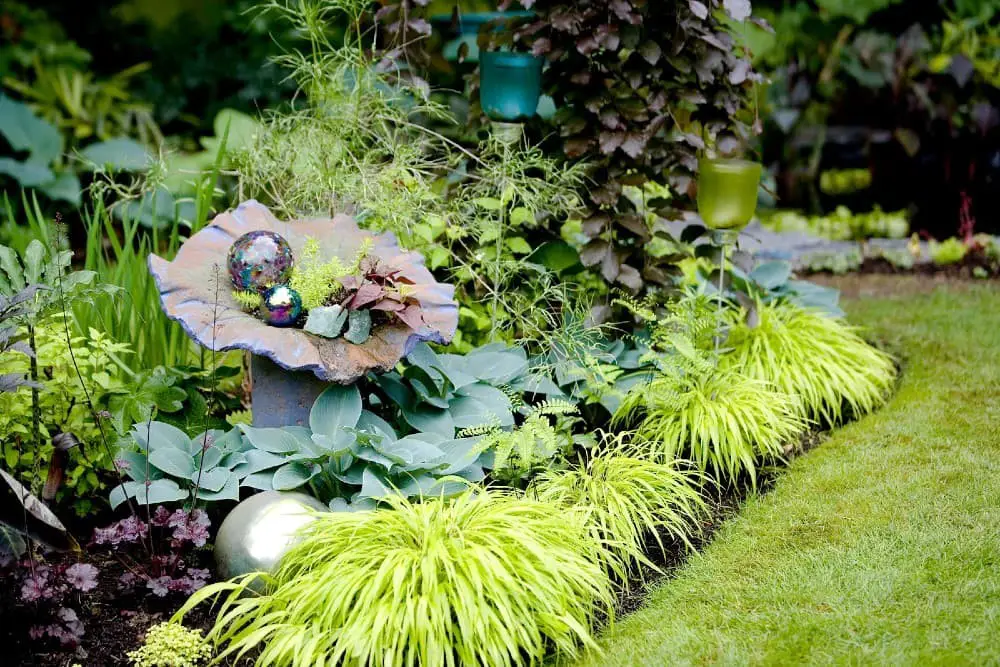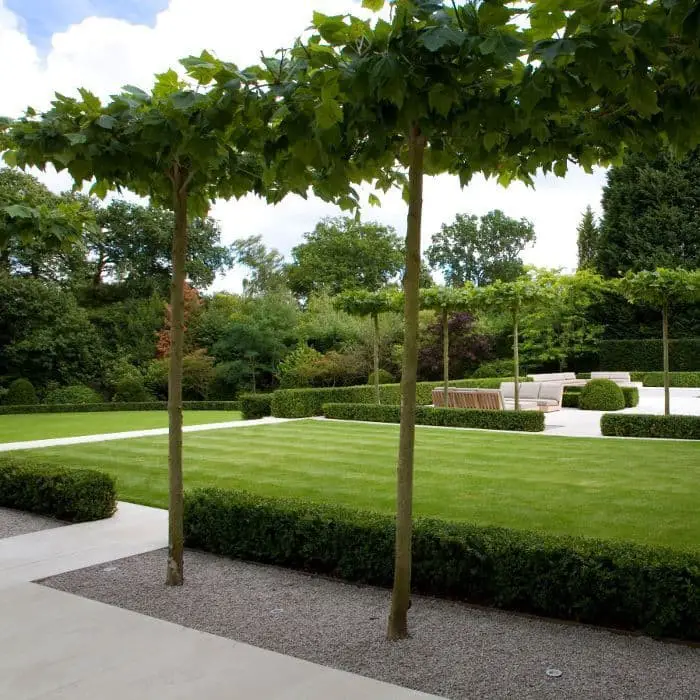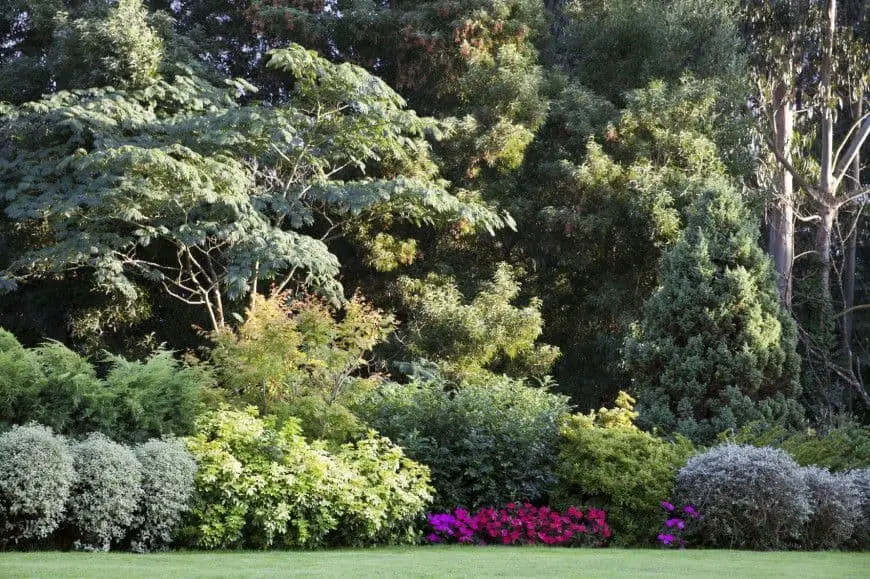35+ Beautiful Shade Garden Ideas And Designs (Photos)
Shade gardens often intimidate people, but they offer a unique opportunity to create a stunning outdoor space despite reduced light levels. Shady borders, which provide a refreshing contrast to sunny areas, can be the most enjoyable part of a garden. After all, shade is an inevitable aspect of gardening. If mature trees were planted by a previous owner to ensure privacy, don’t let those shady regions deter you from designing your dream garden.
With some simple techniques and tricks, you can revive that neglected border or unwelcoming patio area. Explore these 35 innovative shade garden ideas to bring new life to your space.
35 Best Shade Garden Ideas and Designs
Garden Shade in the Backyard

As the mercury rises on a sweltering summer day, a shaded oasis beckons for a refreshing respite with a chilled drink in hand. Moreover, it’s an opportune setting to initiate your gardening journey. To successfully cultivate a thriving garden, you must first select the optimal plants suited to the quantity of light each region receives. Take a moment to sit back in your lawn and conduct a thorough assessment of the light patterns throughout the day.
Some areas may enjoy brief intervals of direct sunlight before gradually transitioning into shaded conditions for the remainder of the day. Conversely, other regions may remain perpetually shrouded in moderate to severe shade, never basking in the warmth of the sun’s rays. For such environments, consider planting heuchera – a vibrant and resilient option that thrives in semi-shaded settings.
Cottage Shade Garden

Transform your yard into a serene retreat by incorporating a gravel or stone pathway that winds through trees and plants. Create a secluded spot with ample space for cozy cafe seating areas. Tall plants can be strategically placed to form a natural border, while shade-loving species are perfect for planting along the pathways. Aim for a less-than-perfectly manicured landscape that exudes charm.
To add visual interest, scatter a variety of flowering plants with different colors and textures throughout the space, allowing their unique qualities to shine.
Front Yard

When it comes to planting under large shade trees, you may find it challenging to coax any growth from the soil. Even the hardiest of grasses can struggle to thrive in these shaded areas.
This can be particularly frustrating given the significant impact your front yard has on your living space’s curb appeal.
The key to a successful and visually appealing front yard is to choose plants that not only bloom but also flourish in partial shade.
To maximize coverage, create distinct landscaping zones around the base of the trees.
By creating plant beds in areas where the grass tends to suffer the most, you can take advantage of these shaded spots and create a beautiful oasis under your tree’s canopy.
Path Through the Garden

To optimize your garden’s usability, a well-designed path is crucial. A pea gravel surface can provide a rustic charm, while large stones embedded in the ground add a touch of elegance. Alternatively, pavers can be used to create a beautiful and functional pathway. For shaded areas, consider using moss as a natural ground cover that can also serve as a grout, filling in gaps between stones and creating a lush, verdant appearance.
To further enhance your path’s visual appeal, plant flowering foliage along either side, creating a picturesque border. Additionally, if you’re experiencing drainage issues, consider installing a stone-lined ditch to direct excess water away from the pathway.
Shade Garden in Japan

Transform your gardening woes into a serene oasis with the wisdom of Japanese aesthetics! A stone garden can be the perfect solution if you’re struggling to grow plants. Start by covering the area with a layer of sand and gravel, then use raked patterns to represent water and carefully placed boulders to evoke mountains. The key is precision – it’s not just about throwing some rocks around. This simple yet elegant approach will help you cultivate a sense of harmony in your outdoor space.
For a more lush alternative, consider creating a mossy Japanese garden. Moss thrives in damp, shaded environments, making this style perfect for backyards with limited sunlight. You don’t need to go all out on specific plants like maple or variegated foliage – simply let the natural beauty of the moss take center stage. The result will be a tranquil retreat that invites relaxation and contemplation.
Shade Garden that has been landscaped

When it comes to planting a shaded garden, timing is everything. The ideal moment to get started is early spring, when most plants enter their growth season, which typically spans from spring to summer. By planting at this time, you’ll significantly boost your chances of successful germination and growth. As you arrange your plants, consider their individual shadow tolerance and how they will interact visually.
Create a layered effect by placing taller plants in the farthest corner and shorter ones closer to the center. This approach allows for visual interest through varying elevations and textures.
Garden with Mossy Shade

Transform your shaded backyard area into a unique and thriving miniature landscape by creating a moss garden. Since succulents and moss prefer damp soil and can survive without much rain, this environment is perfect for them. To add visual interest, build up the ground in areas to create varying heights and textures. Surround the moss with large boulders or stones to provide a natural border.
Then, use moss to cover the entire area and consider adding ferns or a sculpture to create height and depth.
Patio in the Shade

Patio living can be a wonderful extension of your home, but it’s not always sunshine and rainbows. The reality is that many patios receive significant shadow due to their proximity to the main structure. This obstruction can make it challenging to grow certain types of plants, which often require direct sunlight to thrive. To overcome this limitation, consider using pots filled with shade-loving flora.
These adaptable plants won’t mind the reduced sun exposure and will still bring beauty and vibrancy to your outdoor space. For a lower-maintenance option, opt for flowering perennials like ostrich ferns or other varieties that can tolerate partial shading.
Shade Garden in the Narrow Side

Narrow side yards, often situated between two houses or a fence, tend to receive limited sunlight. This restricted exposure can make it challenging for certain plants to thrive. To accommodate these conditions, consider placing shade-loving plants along the rear side of a house where they’ll receive gentle, indirect light without risk of sunburn.
Container gardening is also an excellent approach, as it allows for easy relocation and maintenance, making it ideal for managing this shaded landscape.
Shade Garden in the Tropics

When envisioning tropical flora, it’s natural to associate it with warm sunlight. However, creating a tropic garden in a shaded backyard can be challenging when tropical plants often require direct sunlight. Not all tropical plants thrive in full sun, though – some prefer a lighter hue. In fact, there are many shade-loving species that can thrive beneath the canopy of larger sun-loving plants.
For instance, the dicentra spectabilis prefers dappled shade, growing closer to the soil and beneath the leaves of towering palms.
Shade Garden with Water Feature

Adding a water feature to your landscape design can create a unique sonic and visual experience. For smaller spaces, consider a compact self-contained fountain that can still make a big impact. If you have more room to spare, a small pond or larger water feature can be a great addition to patios or backyards. To create a visually appealing waterscape element, simply arrange stones around the feature.
And for those with even more space, a full-sized pond can be accommodated in a large backyard, making it an ideal spot to keep goldfish or koi. For added interest, consider building a succulent and moss wall around the pond, which will thrive in the moist atmosphere and low light conditions.
Shade Garden in the Woods

Transforming your yard into a woodland oasis is effortless with tall trees providing ample shade. To create a multi-layered atmosphere, incorporate smaller ground cover vegetation around tree stumps, ensuring a seamless transition. Opt for low-growing plants reminiscent of those found in nature, such as ferns and hosta shrubs. These will not only thrive under the shade but also spread out to form an attractive carpet of foliage.
Corten Steel

Urban gardens can thrive in unexpected environments, thanks to the built landscape’s dynamic shading patterns that shift throughout the day. The Agapanthus-lined design of this modern urban oasis, courtesy of Bowles & Wyer, effectively combines contemporary style with welcoming warmth. Meanwhile, Corten steel has become a sought-after material, its earthy hue providing a striking counterbalance to darker tones.
For further inspiration on creative ways to define garden borders, explore our curated selection of contemporary edging ideas.
Blooms and grasses can be used to create shadows.

The arctic wood-rush (Luzula nivalis) and Epimediums create a calming ambiance by blending into the surroundings with their soft, diffused patterns. On the other hand, opulent tulips add an air of grandeur to the arrangement, drawing attention with their vibrant colors. For those who share our passion for tulips, we recommend exploring guides on how to cultivate these beauty-enhancing flowers.
In moderate shade, most varieties will flourish, allowing you to bring a touch of elegance into your daily life.
A peaceful location

Transform your outdoor space into an oasis during the hot summer months by leveraging any available shade. Even a small balcony, courtyard, or patio with partial shading can be transformed into a serene retreat. To achieve this modern and inviting atmosphere, opt for minimalistic furnishings in neutral hues that blend seamlessly with the surrounding environment.
As the warm sun casts its gentle glow, the dancing shadows from nearby trees create a mesmerizing display, making it the perfect spot to unwind on a midsummer’s day.
Plants should be used around a statue.

If modern aesthetics aren’t your cup of tea, consider an alternative that exudes a sense of timeless elegance. Pairing a classic stone statue with an abundance of shade-loving flora creates a captivating and nostalgic atmosphere.
Hostas and ferns are tried-and-true choices for adding depth and visual interest to this setting. Even the most shaded of borders can be transformed into a visually stunning focal point that invites exploration.
We’re particularly fond of how the natural stone grass edging adds to the rustic, earthy charm.
Pale paving is a good choice.

Gaze upon the image provided and witness how a thoughtfully chosen paving concept can utterly revitalize an otherwise uninspiring outdoor space. Rosemary Coldstream, a seasoned garden designer, masterfully demonstrates the transformative power of a light-colored pavement, injecting vibrancy into this previously dull area.
To further elevate the aesthetic, she incorporates a diverse array of foliage, including glossy leaves, an abundance of white flowers, and lush ferns, carefully balancing complexity with a splash of color. For areas shrouded in shade, Coldstream recommends the striking silver-leafed Astelia chathamica ‘Silver Spear’, adding an extra layer of sophistication to the overall design.
Trees and shrubs.

Trees bring a serene charm to any garden, but their shaded areas can pose a challenge for certain plant species to thrive. Nevertheless, there’s a straightforward approach that can create an alluring woodland ambiance. By incorporating chalky soil and a mix of ferns, geraniums, and Galium odoratum with its delicate white blooms, you can craft a captivating landscape that invites contemplation.
For further inspiration, explore our curated list of the top shade-loving plants that complement this unique setting.
Dining al fresco

The living room’s location receives limited sunlight throughout the year, except during the summer months when it briefly enjoys some warmth. To make the most of this natural light, the design needed to be thoughtfully planned to create an inviting atmosphere. This was achieved by incorporating light-reflecting elements such as porcelain marble and DesignClad walling from London Stone, complemented by modern wall lighting that adds a touch of elegance after dark.
For a lush and thriving shade-tolerant planting combination, Japanese forest grass and hydrangea arborescens were chosen to bring in a pop of color and texture.
Plant bulbs in the early spring.

When incorporating shadow garden ideas that pay homage to the woods, consider incorporating lovely bulbs that complement the motif. According to landscape designer Sebastian Conrad, ‘early-flowering summertime snowflakes’ (Leucojum vernum) are an excellent choice for their ability to reflect the serenity of shaded forest regions. These bulbs not only thrive quickly but also attract a diverse array of pollinators, further enriching the natural ambiance.
In shadier environments, lilies of the valley, snowdrops, and certain crocus species can flourish. If you’re working with a shaded patio or balcony, consider arranging them in charming garden planter ideas to create a visually appealing display that brings a touch of woodland charm to your outdoor space.
For a jungle feel, mix ferns together.

To infuse your plot with a lush, jungle-like ambiance, incorporate an abundance of ferns. A comprehensive guide on growing ferns will provide you with the necessary know-how to get started. For instance, the striking silver surfaces of Hart’s-tongue ferns create a visually appealing contrast when paired with natural stone, as garden experts attest. When combined with the holly fern (Cyrtomium fortunei), this striking combination adds an element of intrigue to even the darkest of locations.
Trees that are tabletop

While we’ve explored various ways to maximize the potential of shady gardens, it’s equally important to consider the opposite scenario – a complete lack of shade. In such cases, creative solutions are necessary to create a comfortable outdoor space. One innovative approach is to employ tabletop or roof-trained plants, as exemplified in this charming setting. These plants not only provide a respite from the scorching heat but also add aesthetic value with their beautiful foliage.
For instance, Pyrus calleryana ‘Chanticleer’ pears, as described by garden designer Rosemary Coldstream, boast stunning oranges and red hues in late fall, making them a delightful addition to any patio.
Curved Garden Beds are a great way to add some interest to your garden.

Shade gardens create an inviting atmosphere reminiscent of a serene forest oasis. This is precisely why incorporating curved garden beds proves so effective – in nature, sharp corners and straight lines are scarce. The subtle curvature also cleverly conceals a portion of the garden, piquing one’s curiosity to explore what lies beyond the bend.
Or, for a more formal look, use hedges.

For those who crave a more structured aesthetic, a shade garden is an excellent option to explore. Atop this serene setting, meticulously trimmed boxwood hedges thrive within the canopy. Not only do they provide a beautiful edging for flat garden beds, but they also complement trees that require less sunlight, creating a harmonious coexistence.
Make a Relaxation Area

Transforming your shade garden into an idyllic retreat is a worthwhile endeavor. To truly appreciate its serenity, consider adding a seating area, be it a simple bench, a compact deck, or a cozy patio. Alternatively, you could suspend a hammock to create a tranquil oasis where you can unwind and bask in the peaceful atmosphere.
Set up a few rocks

Natural-looking rocks and boulders can provide a sense of structure to your outdoor space. For a unique feature, consider constructing a retaining wall using an assortment of rock sizes, which would be particularly effective in creating a mountainside-inspired shade garden. Alternatively, you could create a raised bed by piling flagstones together or construct a smaller, tiered bed by stacking tiny flagstones on top of each other.
For the backbone, choose shrubs.

To establish a tiered shade garden, it’s essential to start with taller shrubs that serve as the foundation. Even during the winter months, these plants provide a framework that encloses the garden, setting the tone for the entire space. I find evergreens to be particularly effective in this role, and fortunately, there are many shade-loving options available.
Vines can be used to add height.

When it comes to creating a visually appealing shade garden, incorporating vines can be an excellent way to strike a balance between shrubbery and longer trees. To make the most of this design element, consider installing trellises or posts that provide a structure for the vines to grow upon. As they develop, allow them to intertwine with the surrounding trees and shrubs to create a naturalistic effect that adds depth and visual interest to the space.
Make Use Of A Lot Of Ground Cover

As we strive towards a future where every inch of the earth is blanketed with lush vegetation, several benefits emerge. The resulting verdant landscape not only fosters a serene and shaded atmosphere but also enhances soil moisture retention and suppresses weed growth – effectively reducing maintenance efforts in the long run.
Choose plants with vibrant leaves.

One of the most appealing aspects of shade vegetation is the vast array of leaf colors they exhibit. This means that even during periods when neither plant is in bloom, your landscape can still boast a pleasing aesthetic throughout the seasons. As I design my shadow garden plan, I intend to incorporate this diversity of foliage into its overall appeal.
Incorporate Color Pops

To bring vibrancy and life to your shadow garden, it’s essential to introduce a variety of blooming plants. By thoughtfully selecting a color palette, you’ll be able to create a visually appealing and harmonious space. To ensure year-round interest, include a mix of plants that bloom at different times, allowing you to enjoy the beauty of blossoms throughout the seasons.
The Importance of Repetition

A harmonious garden design relies on repetition and variation in plant placement. One effective technique is to repeat the same plants multiple times across different garden beds, thereby creating a sense of order and visual balance. This approach can also be achieved by alternating two distinct plant species along the bed’s perimeter or, conversely, featuring a large-scale planting of a single cultivar.
By incorporating these principles, you can craft a serene landscape that eschews chaos in favor of a soothing atmosphere.
Fruit should be grown for foraging.

When it comes to adding variety to your outdoor space, consider cultivating fruits and vegetables that thrive in shade. This can not only provide a unique texture but also elevate the flavor profile. Think beyond typical sunny spots and explore options like raspberries, gooseberries, redcurrant, and rhubarb. The abundance of fruit that can be foraged in wooded forests, growing beneath the canopy’s soft filter, is a treasure trove waiting to be discovered.
To make an effect, add containers.

Container gardening offers unparalleled flexibility, allowing you to adapt your outdoor space as the seasons shift. This versatility enables you to incorporate shade-tolerant blooms, injecting vibrant pops of color into your surroundings. Furthermore, this concept facilitates precise monitoring of a plant’s progress, permitting adjustments to its placement if necessary, ensuring optimal growth and thriving under the perfect amount of quiet sunlight.
Plant a vegetable garden in the shade.

While it’s perfectly fine to allocate a portion of your vegetable patch to shaded areas, many vegetables can indeed thrive there. Carrots, runner beans, peas, spinach, beets, chard, kale, and even green salads are all suitable options for raised beds with partial shade. When starting from seed, consider beginning them in a sunnier spot to help their roots establish before gradually transitioning them to a moderate shade area for optimal growth.
FAQs
How do you layout a shade garden?
A shade garden offers numerous opportunities for creative design, with one of its most significant advantages being the ability to maintain a comfortable ambiance even during scorching summer days. The soothing atmosphere of this serene oasis is further enhanced by the gentle sound of running water and the inviting texture of stone pavers, creating an ideal setting for leisurely strolls.
With its calming effects and peaceful ambiance, a shade garden provides the perfect retreat from the hustle and bustle of everyday life.
What can I do with my shaded garden area?
While traditional gardens often require direct sunlight, shade gardens offer an alternative that’s just as vibrant and thriving. By creating reduced light regions, you can cultivate plants that wouldn’t survive in full sun, much like how bright gardens enable you to grow certain species that struggle in dull environments. Additionally, a shade garden provides a respite from the heat, allowing you to work or relax without the burden of intense sunlight.
As you unwind amidst the natural surroundings, shaded by trees and vegetation, you’ll find solace in the peaceful ambiance.
Conclusion
While gardening in the shade can be a challenge, it’s also an opportunity to focus on plants that excel in conditions with less intense sunlight. Rather than trying to force sun-loving plants into your yard, why not lean into the natural ambiance and cultivate a unique landscape that showcases the beauty of shade-tolerant flora? By doing so, you’ll not only find success but also create a one-of-a-kind haven that’s perfect for relaxing or entertaining.
To get started, take some time to envision the kind of landscape you want to create – is it a serene retreat with lush greenery and delicate blooms, or a vibrant oasis with bold colors and textured foliage? Whatever your vision, we hope these ideas will inspire you to make the most of your shade and bring your outdoor space to life.
Related Posts
When it comes to your farm business, choosing the right equipment can be a crucial decision. You’re not just investing in machinery, you’re investing in the future of your operation. From tractors and plows to irrigation systems and harvesting tools, the type of equipment you select will directly impact your productivity, efficiency, and profitability. The same level of consideration should also apply when it comes to installing a fence around your home.
Not only does it provide physical protection, but it can also boost property values and deter unwanted visitors. Then there are the services that keep our homes running smoothly, like driveway sealers. While tipping for these services is not always expected or required, understanding the etiquette surrounding gratuities can help you navigate these situations with confidence.
Lastly, if you’re considering a career in landscape architecture or design, or even photography specializing in gardens and flora, there’s no shortage of opportunities. By following your passion and dedicating yourself to honing your skills, you can build a flourishing career that brings joy and fulfillment to both yourself and others.






